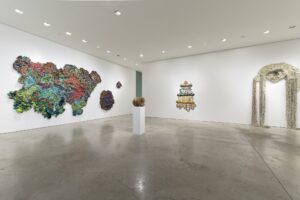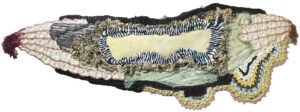The group show “Unusual Material and Forms for a New Aesthetic” at Primo Marella Gallery has just ended. The exhibition, aimed at underlining the complexity of the arts in Africa, exposed a connection between artists, from different backgrounds, who use form and matter as tools of investigation, crossing the different policies present in their own countries. The innovative practices of the six artists from Mali, Nigeria, Zimbabwe and Madagascar came together to recall the particularities. In the Milan exhibition emerged the work of Troy Makaza, who was selected for the Zimbabwe Pavilion at the 60th Venice Biennale.

Various Artists, “Unusual Materials and Forms for a New Aesthetic”, installation view, photo Greta Belintende, courtesy of the artists and Primo Marella Gallery
His artistic practice derives large sculptural illustrations from the juxtaposition of industrial silicones infused with inks and paints. This material produces a malleable compound that can be cast, braided and bonded. Makaza uses it to superimpose painting and sculpture, two media that are often aggressively separated. Tables, food and, sometimes, drugs emerge from his wall sculptures. The filter of food and diet, among others, resonates with the challenges of Zimbabwe, which the artist conceptualizes by dividing into traditional observation and contemporary setting. He introduced both the customs of his nation, such as the weaving present in ancient tapestries, and generated a desire for innovation. «The medium is intimately linked to my work on different levels. First, it combines a traditional art medium with a new one. This is something I am very aware of doing as a contemporary artist from Zimbabwe, blending tradition with contemporary practice. Secondly, this medium allows me to move between sculpture and painting and to break the categories established by people who are not us, so in a way it is as if I am affirming my right as an artist to determine how I am seen and not to allow myself or my content to be categorized. My subject is just as fluid and moves between abstraction and figuration because neither category is, in fact, pure and the formality of these definitions makes no sense to me» the artist states. Makaza is a social policymaker. One of the issues that most increases his struggles is the theme of greed and deprivation of resources, of which Zimbabwe is very rich. The seductive but corrosive politics is here laid bare by the artist, bringing the protest movements into the artistic and social context. Troy Makaza tells us about it in this interview.
Troy Makaza, “Meaning responsibility and contentment part 3”, 2022, silicone infused with paint, 218 × 114 cm, courtesy of the artists and Primo Marella Gallery
Alessia D’introno: What social or political themes of Zimbabwe recur in your works?
Troy Makaza: Cattle, land and grain resemble wealth in most African cultures. In my work these three play a major role in showing the power struggles within my imaginary spaces. In recent years I have been looking at “politics of the stomach” as a main theme. I try to find a balance on how power and resources are shared or allocated in social spheres. The impact of these power struggles has had a huge effect on my generation which is dubbed the born free generation (those born after 1980 when Zimbabwe got its independence), these are personal experiences influenced by my surroundings from expectations of society to the impact of the rise of cost of living. It’s not just a matter of daily survival but also how to find order out of chaos.
Among the works in the Milan exhibition, “Meaning responsability and contentment pt.3” presents a reflection on this politics of the stomach, on food. How is this work connected to your hometown?
To me food is a universal language which determines the social status of any individual or state. Our daily diet can be influenced by the availability of resources and I find a lot of politics controlling who gets what and when.

Troy Makaza, “Not titled yet”, 2023, silicone infused with paint, 103 × 276 cm, courtesy Primo Marella Gallery and the artist
Where does the practice of works woven from painted silicone strings come from?
Silicone infused with paint strings is just one way I express my thoughts and ideas. It started with how best I can transform the material from its original use. Making it into strings and tying knots became a way of symbolizing how there is strength in numbers and also the social ties within my country. Some strings are pasted together in a way that resembles farming lines and this speaks about how land and agriculture is directly linked to the history and existence of the nation Zimbabwe.
To conclude: a curiosity about the future. What are the main themes you will introduce at the 60th Venice Biennale?
PFor the 60th Venice Biennial you can expect more form and texture and one of my first free standing silicone sculptures. I will reintroduce current themes but from a different perspective, I have been researching on the history of colonial Rhodesia and some similarities to the current republic. At this point patriotism is the goal.
Alessia D’Introno
Info:
Alessia D’introno has a degree in Visual Arts and is currently attending the two-year specialist course in Visual Arts and Curatorial Studies at Nuova Accademia di Belle Arti, NABA, Milan. She writes for the print and online magazine Juliet Art Magazine. Her critical work focuses on the demolition of historical paradigms to which Italy and Europe have been linked for centuries. The de-colonial practice of her research develops a comparison and an openness towards new methodologies and possibilities.






NO COMMENT